Titanic’s Cream of Barley Soup

Step aboard the luxury liner of flavor with this exquisite cream of barley soup that graced the first-class dining rooms of the Titanic!
This isn’t your ordinary peasant soup – it’s an elegant, refined dish that transforms humble pearl barley into pure sophistication.
The silky, strained broth enriched with egg yolk creates an incredibly smooth texture that melts on your tongue, while the aromatic blend of sautéed vegetables and freshly grated nutmeg delivers layers of complex flavor that would make even the Astors swoon.

What makes this recipe truly spectacular is the traditional tempering technique that creates that signature creamy richness without a drop of heavy cream.
The long, slow simmering process allows every ingredient to meld into perfect harmony, creating a soup so refined it could grace any modern fine-dining table.
The contrast between the earthy barley and the bright, fresh parsley garnish creates a visual and textural masterpiece that’s both comforting and elegant.
Get ready to experience culinary history in the most delicious way possible!

Ingredients
For the soup base
- 1 /3 cup pearl barley
- 2 tablespoons unsalted butter
- 1 small onion, finely chopped
- 1 small carrot, finely chopped
- 1 stalk celery, finely chopped
- 8 cups high-quality chicken stock
For the finishing touches
- 1 large egg yolk (save the white for another use)
- 1 pinch salt and freshly ground black pepper
- 1 whole nutmeg, freshly grated
- 2 sprigs fresh parsley, chopped for garnish
Optional garnishes
- Fried bread croutons
- Nonfat strained yogurt for drizzling

Instructions
Prepare the barley
- 1 Rinse the 1/3 cup pearl barley under cold running water until the water runs clear. Place in a medium saucepan with cold water to cover by 2 inches.
- 2 Bring to a rolling boil over high heat and cook for 3-4 minutes. Drain through a fine-mesh sieve and let cool completely. This pre-cooking step removes excess starch and prevents the soup from becoming gummy.
Build the flavor base
- 3 Heat 2 tablespoons unsalted butter in a heavy-bottomed saucepan over medium heat until it begins to foam and smell nutty, about 2-3 minutes.
- 4 Add the finely chopped onion, carrot, and celery to the melted butter. Sauté until the vegetables are lightly golden and fragrant, about 8-10 minutes, stirring occasionally to prevent burning.
Simmer and develop flavors
- 5 Add the cooled barley and 8 cups chicken stock to the saucepan. Bring to a gentle boil, then reduce heat to maintain a steady simmer.
- 6 Simmer uncovered for 1-2 hours, stirring occasionally. The longer cooking time allows the flavors to fully develop and the barley to release its natural starches, creating a more complex, refined taste.
Strain and season
- 7 Pour the entire mixture through a fine-mesh strainer into a clean saucepan, pressing the solids gently to extract maximum flavor. Reserve the strained vegetables and barley for another use or enjoy as a cook’s snack.
- 8 Season the clear broth with freshly grated nutmeg, salt, and freshly ground black pepper to taste. The nutmeg should be barely detectable – just a whisper of warmth.
Temper and finish
- 9 In a small bowl, whisk the egg yolk until smooth. Slowly ladle 1/4 cup of the hot broth into the egg yolk, whisking constantly to prevent curdling.
- 10 Gradually stir the tempered egg mixture back into the soup pot, whisking continuously. This technique ensures a silky, enriched broth without scrambled eggs.
- 11 Reheat the soup gently over low heat until steaming hot, but do not allow it to boil or the egg will curdle. The soup should coat the back of a spoon lightly.
- 12 Serve immediately in warmed bowls, garnished with chopped fresh parsley, fried bread croutons, and a drizzle of nonfat yogurt if desired.
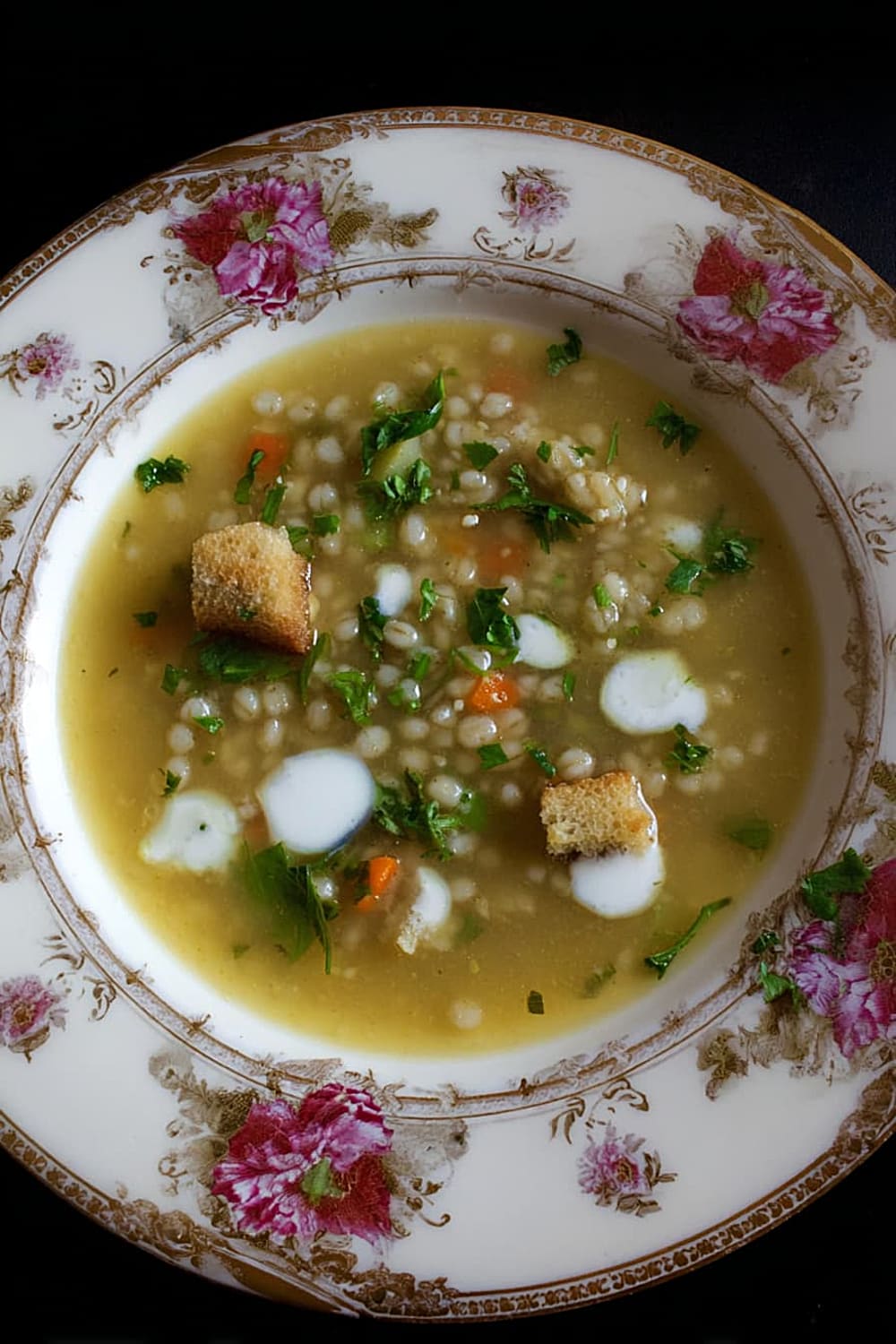
Recommended Equipment and Kitchen Tools
Essential Tools (for best results):
- Fine-mesh strainer – Critical for achieving the signature smooth, clear broth that defines this elegant soup
- Heavy-bottomed saucepan – Prevents scorching during the long simmering process and ensures even heat distribution
- Instant-read thermometer – Helps monitor temperature when tempering the egg yolk to prevent curdling
- Microplane grater – Creates the finest nutmeg gratings for optimal flavor distribution without grittiness
Helpful Upgrades:
- Kitchen scale – For precise barley measurements, especially when scaling the recipe up or down
- Immersion blender – While not needed for the traditional strained version, useful if you prefer a partially blended texture
- Ladle with pour spout – Makes the tempering process much easier and more controlled
Nice-to-Have Options:
- Soup tureen – Perfect for elegant presentation when entertaining guests
- Warmed soup bowls – Professional touch that keeps the soup at optimal serving temperature
- Small whisk – Ideal for the egg tempering process, though a fork works in a pinch
Remember, these tools enhance your cooking experience but aren’t mandatory – this recipe was originally made with basic Victorian-era equipment!
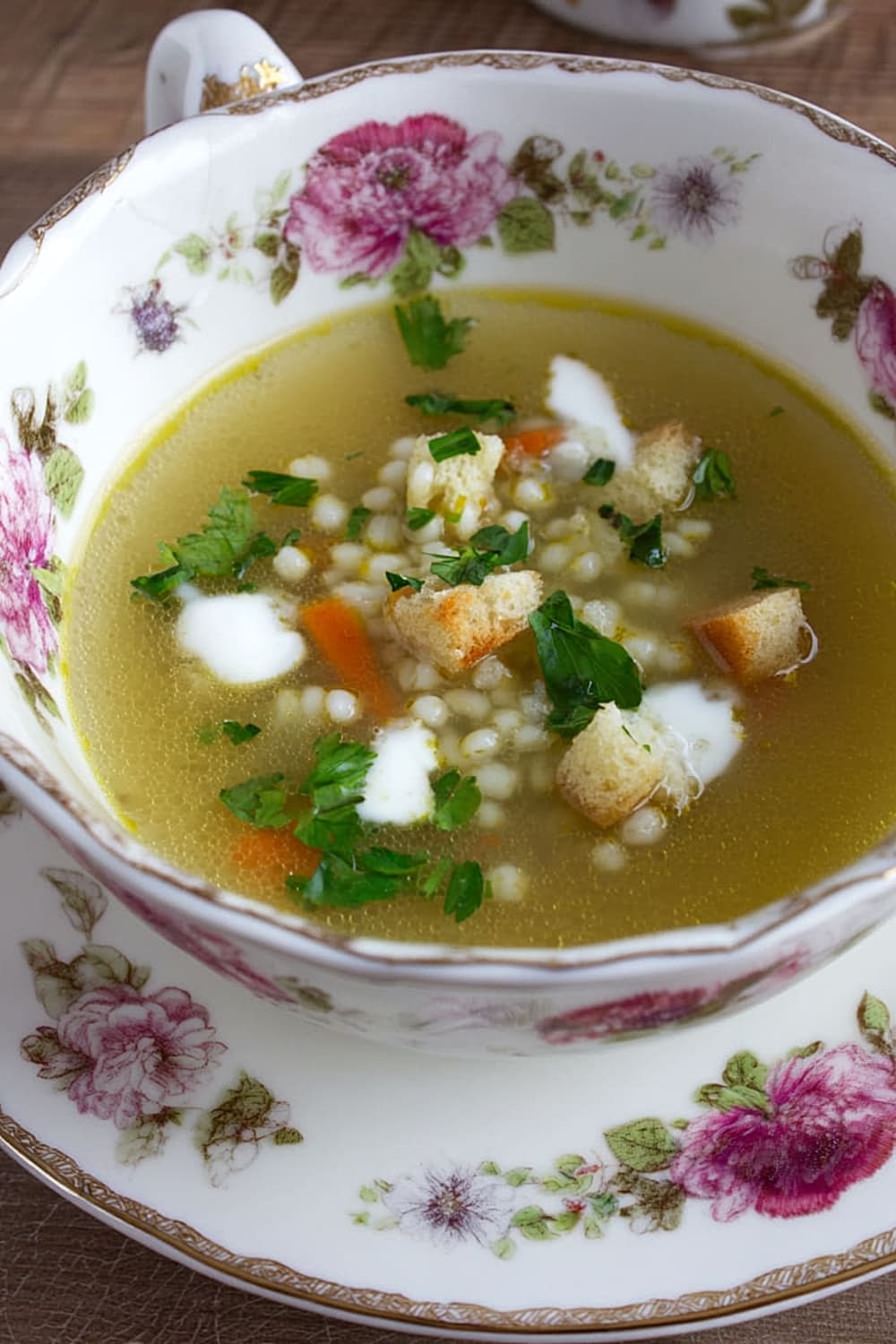
Recipe Variations and Dietary Modifications
Gluten-Free Adaptation:
- Substitute pearl barley with 1/3 cup quinoa or 1/4 cup rice for a naturally gluten-free version
- Cooking time reduces to 30-45 minutes with these alternatives
- Quinoa provides a nuttier flavor while rice creates a more neutral base
Dairy-Free Modifications:
- Replace butter with 2 tablespoons olive oil or coconut oil for sautéing vegetables
- The coconut oil adds subtle richness while olive oil keeps the flavor more traditional
- No other dairy modifications needed as this recipe is naturally dairy-light
Vegan Version:
- Use 8 cups vegetable stock instead of chicken stock for the base
- Replace egg yolk with 2 tablespoons cashew cream or 1 tablespoon cornstarch mixed with 2 tablespoons cold water
- Add 1 teaspoon nutritional yeast for extra depth and umami flavor
Heartier Family-Style Version:
- Don’t strain the vegetables and barley – leave them in for a more substantial soup
- Add 1 cup diced potatoes during the last 30 minutes of cooking
- Increase seasoning proportionally for the additional ingredients
Flavor Variations:
- Herb-infused: Add 2 bay leaves and fresh thyme sprigs during simmering
- Lemon brightened: Finish with 1 tablespoon fresh lemon juice and lemon zest
- Mushroom enhanced: Sauté 4 ounces sliced mushrooms with the vegetables
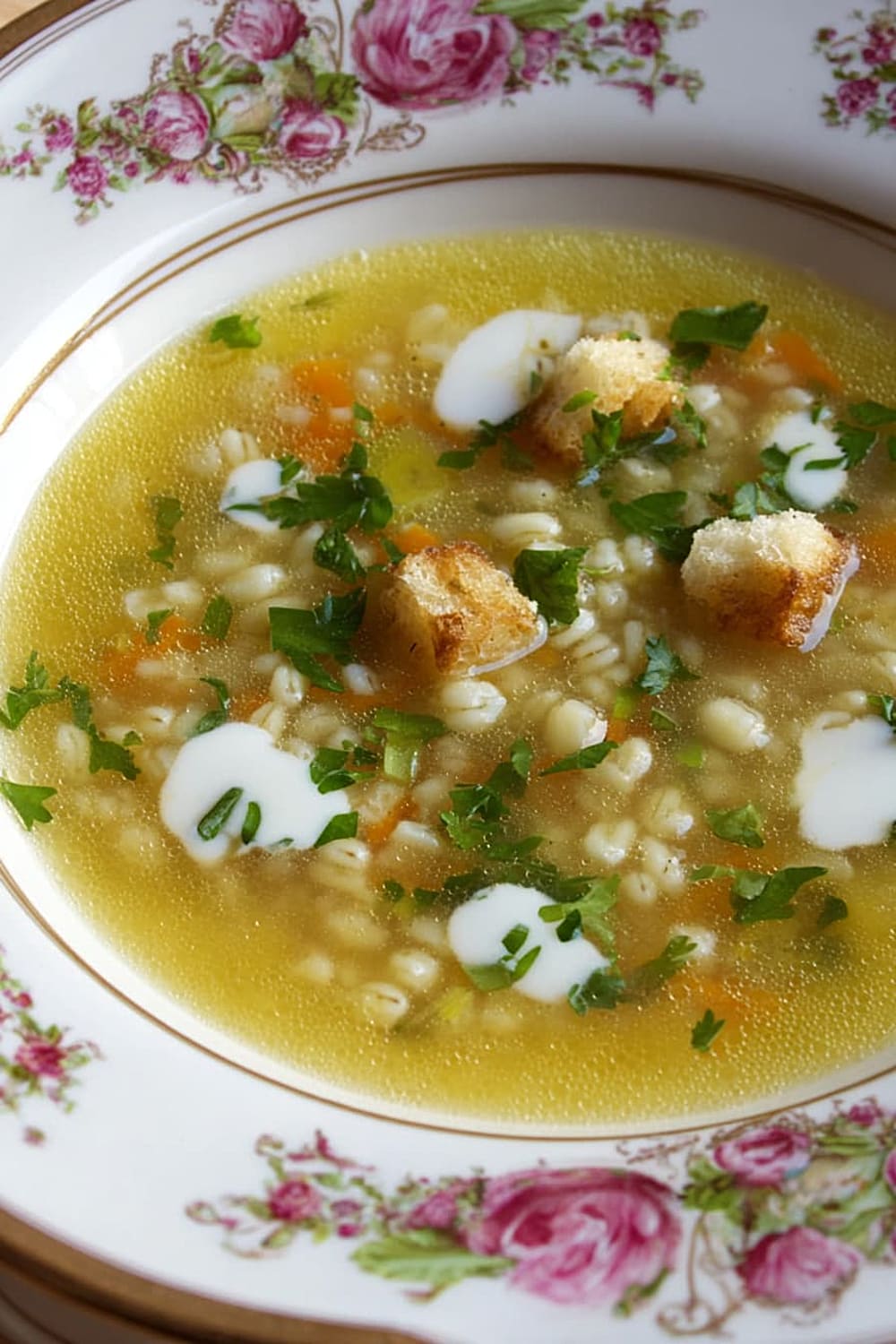
Nutritional Information and Health Benefits
Key Nutritional Highlights:
This refined soup delivers approximately 95 calories per serving while providing substantial nutritional value. The pearl barley contributes complex carbohydrates and 4 grams of fiber per serving, supporting digestive health and providing sustained energy. The egg yolk adds high-quality protein and essential fatty acids, while the vegetable base provides vitamins A and C from the carrots and celery.
Health Benefits of Main Ingredients:
Pearl barley stands out as a nutritional powerhouse, containing beta-glucan fiber that helps lower cholesterol levels and regulate blood sugar. The long cooking process breaks down the barley’s tough outer layer, making these nutrients more bioavailable. Chicken stock provides collagen and minerals extracted from bones during the cooking process, supporting joint health and providing electrolytes. Fresh nutmeg contains antioxidant compounds and has been traditionally used to aid digestion, while the aromatic vegetables contribute phytonutrients and natural flavor compounds.
Dietary Considerations:
This soup is naturally low in saturated fat and contains no added sugars. It’s suitable for Mediterranean and anti-inflammatory eating patterns. The recipe contains eggs and is gluten-containing due to the barley. Each serving provides approximately 12 grams of carbohydrates, making it moderate for those monitoring carb intake. The high water content and fiber make it very satisfying despite the relatively low calorie count.

Smart Swaps and Ingredient Substitutions
Common Substitutions:
- Pearl barley → 1/4 cup steel-cut oats or 1/3 cup farro (adjust cooking time to 45 minutes)
- Chicken stock → Vegetable stock or bone broth for different flavor profiles
- Fresh nutmeg → 1/8 teaspoon ground nutmeg (use sparingly as ground is more concentrated)
- Egg yolk → 2 tablespoons heavy cream for similar richness without tempering
Budget-Friendly Swaps:
- Homemade stock → High-quality bouillon cubes or stock concentrate (reduce salt accordingly)
- Fresh herbs → Dried parsley (use 1/3 the amount)
- Butter → Olive oil or vegetable oil for sautéing
Pantry Emergency Substitutions:
- Fresh vegetables → 1/2 cup frozen mirepoix (no need to thaw first)
- Whole nutmeg → Pinch of ground cinnamon plus ground cloves for warmth
- Fresh parsley → Chives, green onion tops, or fresh dill for color and freshness
Pro Tips for Substitutions:
- When using quick-cooking grains like quinoa, add them during the last 20 minutes to prevent overcooking
- Store leftover egg whites in the freezer for up to 3 months for future baking projects
- Taste and adjust seasoning after any substitution, as different ingredients may require different salt levels
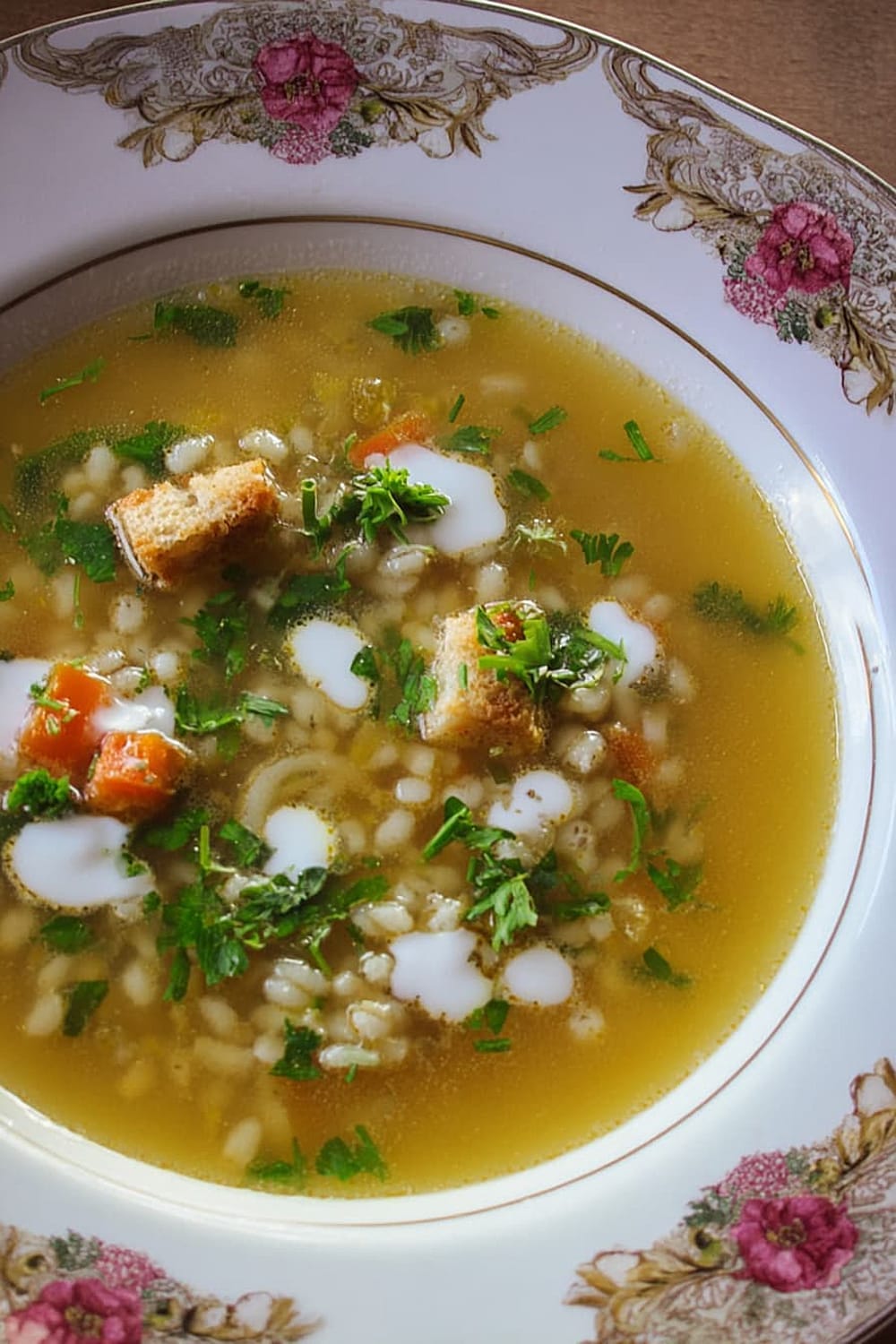
Make It Diabetes-Friendly
Carb Modifications:
- Reduce barley to 2 tablespoons to lower carb content from 12g to approximately 6g per serving
- Add extra vegetables like diced zucchini or cauliflower during the last 15 minutes for volume without carbs
- Increase protein with shredded cooked chicken breast (1/2 cup adds 4g carbs)
Portion & Timing Tips:
- Serve smaller portions (3/4 cup instead of 1 cup) as an appetizer rather than main course
- Pair with protein like grilled chicken or fish to slow glucose absorption
- Add healthy fats with a drizzle of extra virgin olive oil or avocado slices
- Estimated carbs per serving: 6-8g with modifications
Blood Sugar Management:
- Eat with fiber-rich salad to further slow carbohydrate absorption
- Time consumption with regular meal schedule for better glucose control
- Monitor portions carefully as the refined texture makes it easy to overconsume
Enhanced Nutrition:
- Add spinach or kale during the last 5 minutes for extra nutrients without significant carbs
- Use bone broth for additional protein and minerals
- Include turmeric for anti-inflammatory benefits
Total Carb Reduction: Modified version contains approximately 50% fewer carbs than the original while maintaining the elegant flavor profile.

Perfect Pairing Suggestions
Beverage Pairings:
A crisp Sauvignon Blanc or Pinot Grigio complements the soup’s delicate flavors without overwhelming the subtle nutmeg notes. For non-alcoholic options, sparkling water with lemon or chamomile tea enhance the refined dining experience. Light beer like Pilsner works beautifully for casual occasions, while dry sherry echoes the Edwardian era authentically.
Side Dish Recommendations:
Serve alongside crusty artisan bread or herb-crusted dinner rolls for textural contrast. Simple mixed greens salad with lemon vinaigrette provides fresh brightness that cuts through the soup’s richness. Roasted root vegetables like parsnips or turnips echo the soup’s earthy flavors while adding substance. Cheese and charcuterie board transforms this into an elegant appetizer course.
Complete Meal Ideas:
Begin with this soup as a sophisticated first course, followed by roasted chicken or pan-seared fish with seasonal vegetables. For vegetarian menus, pair with mushroom Wellington or herb-crusted salmon. Lemon posset or panna cotta makes an appropriately light dessert that won’t compete with the soup’s delicate flavors.
Occasion Suggestions:
Perfect for formal dinner parties, holiday entertaining, or anniversary celebrations where you want to impress guests with culinary history. The soup’s elegant presentation makes it ideal for winter dinner parties or themed historical meals. Serve in fine china bowls with silver spoons for authentic period presentation.

Pro Tips and Troubleshooting
Professional Techniques:
Always strain the soup through a fine-mesh sieve twice for restaurant-quality clarity. Warm your serving bowls in a 200°F oven for 5 minutes before ladling – this keeps the soup at optimal temperature longer. When tempering the egg yolk, use a figure-eight whisking motion to incorporate the hot liquid more evenly and prevent curdling.
Common Mistakes and Solutions:
If your soup becomes cloudy, it usually means the heat was too high during simmering – always maintain a gentle bubble. Curdled egg yolk can be rescued by immediately whisking in cold stock and straining. Over-salted soup can be corrected by adding more stock or a peeled potato during the last 15 minutes of cooking.
Storage and Reheating:
Store in the refrigerator for up to 3 days in airtight containers. Reheat gently over low heat, whisking occasionally – never microwave as it will break the egg emulsion. The soup can be made up to the straining step 2 days ahead; add the egg yolk just before serving for best results.
Scaling Tips:
This recipe doubles easily, but increase cooking time by 30 minutes for larger batches. When serving a crowd, keep the soup warm in a slow cooker on low after adding the egg yolk. For smaller portions, the recipe halves perfectly – just use one egg yolk regardless of batch size.
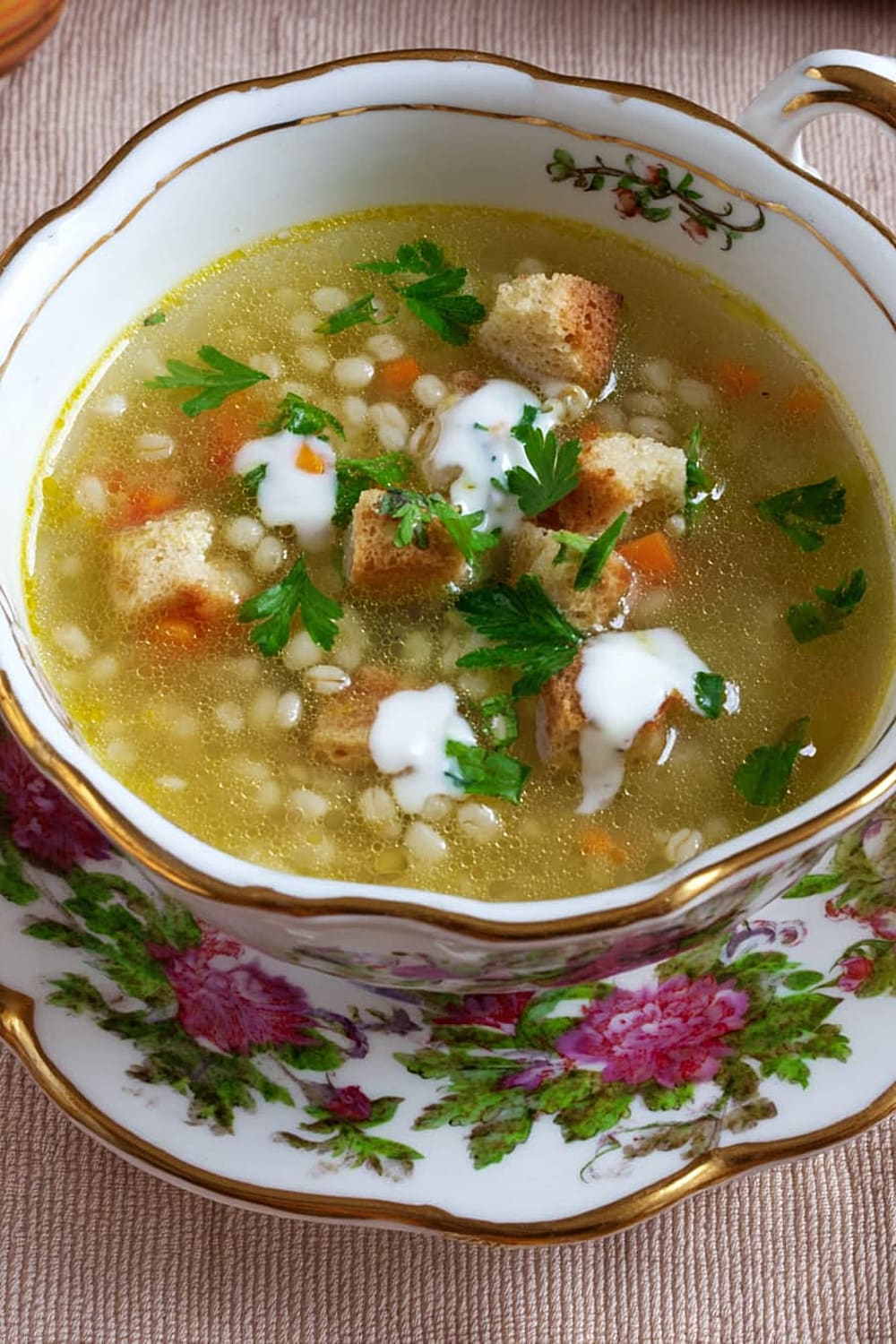
Transport yourself back to the golden age of ocean travel with every spoonful of this historically authentic cream of barley soup. The elegant simplicity and refined technique behind this recipe prove that sometimes the most sophisticated dishes come from the most humble ingredients, transformed through patience and proper technique into something truly extraordinary.